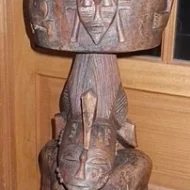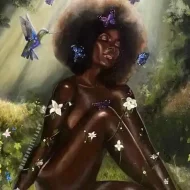Asase Yaa : The Earth Goddess
Listen
At a glance
| Description | |
|---|---|
| Origin | Ashanti Mythology |
| Classification | Gods |
| Family Members | Nyame (Father), Nyankapon (Husband), Bea, Tano, Anansi (Children) |
| Region | Ghana, Ivory Coast |
| Associated With | Earth, Truth, Peace, Fertility, Harvest |
Asase Yaa
Introduction
Asase Yaa, also known as Asase Afua, stands as a revered figure in Ashanti mythology, originating from the vibrant culture of Ghana. Recognized as the earth goddess, she holds a prominent place as the primordial mother of humanity. As a symbol of fertility, sustenance, and the intricate interconnectedness of all living beings, Asase Yaa is esteemed as the giver of life and the cradle of souls. Serving as the gateway to the ancestral realm, she encapsulates the very essence of Earth’s abundance and its enduring ties to humanity. Beyond a conventional deity, Asase Yaa emerges as the Earth Goddess, a potent and benevolent force that has profoundly influenced the worldview of the Ashanti people across generations.
Physical Traits
In one depiction, Asase Yaa is characterized as an elderly woman, aligning with the alternate meaning of her name, “Old Mother Earth.” In this manifestation, she is revered as the Goddess presiding over barren terrains. Conversely, Asase Afua, another facet of Asase Yaa, is portrayed as a youthful and exceptionally beautiful woman. This rendition designates her as the Goddess overseeing fertile landscapes. The contrasting depictions of age and beauty symbolize the dual nature of Asase Yaa, representing both the wisdom of ancient Earth and the vibrancy of its life-giving forces.
When depicted as an elderly woman, Asase Yaa’s visage reflects the ancient wisdom of the Earth. Wrinkles on her face tell the tales of seasons passed and generations gone by. Her skin mirrors the hue of fertile soil, embodying the life force coursing through her veins. Deep and knowing, her eyes hold the universe’s secrets, mirroring the starry night sky and the ocean’s shimmering depths. A crown of twisted roots and verdant leaves adorns her hair, symbolizing her profound connection to the plant world. Garments woven from rivers’ shimmering currents and golden sunlight drape her, showcasing her dominion over the Earth’s diverse elements. Asase Yaa’s portrayal encapsulates the intricate tapestry of the natural world and her multifaceted role within it.
Family
Within the Akan Ashanti Pantheon, known as the Abosom, Asase Yaa holds a distinguished position as the daughter of the Supreme God, Nyame. Her union with Nyankapon, the male sky deity, resulted in the birth of two children, Bea (also known as Bia) and Tano. Notably, in certain folklore, Asase Yaa is depicted as the mother of Anansi, the trickster, and is revered as the divine stepmother of the sacred high chiefs.
As a central figure in the Ashanti pantheon, Asase Yaa’s significance is second only to Nyame, the Supreme Sky God. According to mythology, Nyame created Asase Yaa as the Earth, nurturing her with celestial power. Together, they lay the groundwork for the Ashanti universe, embodying the harmonious interplay of celestial and terrestrial forces. As the mother of all living things, including ancestors, Asase Yaa cradles them in her womb before their worldly entry and welcomes them back into her embrace upon their departure. This pivotal role as a bridge between the physical and spiritual realms is encapsulated in her title, “Aberewaa,” meaning “Old Woman.” In this intricate cosmology, Asase Yaa’s story unfolds as an essential narrative connecting the divine and the mortal within the Ashanti belief system.
Other names
The appellation ‘Asase’ finds its roots in the Twi language, signifying ‘Land.’ Adding to its nuanced significance, ‘Ya’ translates to ‘one born on Thursday,’ suggesting that Asase Yaa was created on this particular day. Conversely, the name ‘Afua’ conveys ‘one born on Friday,’ implying a creation day of Friday for Asase.
This linguistic distinction results in the Asante and many other Akans referring to her as ‘Asase Ya,’ meaning ‘Earth born on Thursday.’ On the other hand, the Fante and some other Akans designate her as ‘Asase Efua (Afua),’ denoting ‘Earth born on Friday.’ The Asante community also recognizes Asase Yaa as Aberewaa, signifying ‘old woman.’ Another epithet, ‘Asase bo ne nsie,’ translates to ‘Earth, creator of the underworld,’ further enriching the layers of her identity.
Asase Yaa’s name, thus, carries profound connotations. ‘Asase’ directly translates to ‘Earth,’ and ‘Yaa’ specifically denotes a female born on Thursday, the day believed by many Akan people to be the day of Nyame’s creation of the Earth. However, among the Fante people, who attribute the Earth’s creation to Friday, Asase Yaa is alternatively acknowledged as ‘Asase Efua,’ meaning ‘female born on Friday.’ These linguistic intricacies underscore the diverse cultural interpretations surrounding Asase Yaa and the dynamic narrative that defines her legend.
Powers and Abilities
As the goddess of Earth’s barren landscapes, Asase Yaa holds a pivotal role in ensuring the fertility of the land and the well-being of its people. Particularly invoked during planting and harvesting seasons, she is deeply entwined with the agricultural cycles that sustain communities. Beyond her agricultural influence, Asase Yaa also assumes the mantle of the Goddess of Truth and Peace, often consulted in matters of community through divination.
Her significance extends to the spiritual realm as the Goddess of Truth and the Mother of the dead, presiding over the gateway to Asamando, the Akan Ancestral Realm. In death, Asase Yaa reclaims her mortal children, symbolizing humanity’s cyclical connection to the Earth. Endowed with immense power and a diverse range of abilities, she governs Earth’s resources, nurturing crop growth, shaping landscapes, and overseeing the flow of rivers and minerals. Her authority over fertility ensures the continuity of life and the prosperity of communities.
As a font of wisdom, Asase Yaa provides guidance and protection to those who seek her favor. In matters of justice, she holds sway as the mediator of disputes, ensuring karmic balance within the community. Acting as the guardian of the ancestral realm, she welcomes the departed into her embrace and facilitates communication between the living and the dead. Asase Yaa, with her multifaceted powers and benevolent influence, emerges as a central figure embodying the interconnectedness of life, justice, and the spiritual dimensions in Ashanti mythology.
Modern Day Influence
Asase Yaa maintains paramount significance among the Akan people, serving as a conduit for ancestral connections through libation and dance. She is revered in the agricultural landscapes of the Asante and other Akans, where worship takes the form of sacrificial offerings to garner favor and blessings. Notably, the Bono people are regarded as Asase Yaa’s favored community.
As the symbol of Planet Earth, Asase Yaa’s influence extends far beyond traditional boundaries. Within the Ashanti community and beyond, her presence is acknowledged and celebrated through traditional ceremonies and rituals. These ceremonies seek her blessings for abundant harvests, successful endeavors, and harmonious relationships. Offerings of food, drink, and libations are poured onto the Earth, expressing gratitude and profound respect.
The Akan day-naming system, which assigns names based on the day of the week, underscores the enduring importance of Asase Yaa in their cosmology. This naming tradition reflects the intertwined relationship between the people and the Earth Goddess. Moreover, Asase Yaa’s timeless message promoting respect for the environment and a profound connection to the Earth aligns with contemporary concerns about sustainability and environmentalism. Her influence persists, bridging cultural traditions with modern-day aspirations for a harmonious and sustainable world.
Related Images
Frequently Asked Questions
What is lorem Ipsum?
I am text block. Click edit button to change this text. Lorem ipsum dolor sit amet, consectetur adipiscing elit. Ut elit tellus, luctus nec ullamcorper mattis, pulvinar dapibus leo.
What is lorem Ipsum?
I am text block. Click edit button to change this text. Lorem ipsum dolor sit amet, consectetur adipiscing elit. Ut elit tellus, luctus nec ullamcorper mattis, pulvinar dapibus leo.
What is lorem Ipsum?
I am text block. Click edit button to change this text. Lorem ipsum dolor sit amet, consectetur adipiscing elit. Ut elit tellus, luctus nec ullamcorper mattis, pulvinar dapibus leo.
What is lorem Ipsum?
I am text block. Click edit button to change this text. Lorem ipsum dolor sit amet, consectetur adipiscing elit. Ut elit tellus, luctus nec ullamcorper mattis, pulvinar dapibus leo.
What is lorem Ipsum?
I am text block. Click edit button to change this text. Lorem ipsum dolor sit amet, consectetur adipiscing elit. Ut elit tellus, luctus nec ullamcorper mattis, pulvinar dapibus leo.









